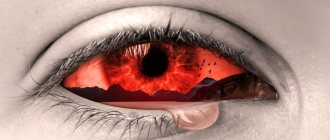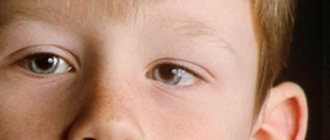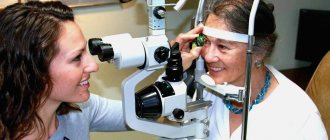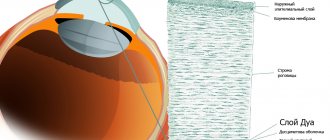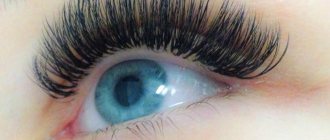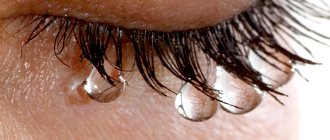Eyes are one of the most complex and vulnerable organs of the human body. By neglecting basic safety measures, anyone can injure the eye apparatus in a variety of circumstances.
Most often, apart from natural pathologies, the eyes suffer from blunt injuries. In essence, they represent mechanical damage to the visual system, which is caused by a direct impact on it and is not normal.
Blunt eye injuries are often not dangerous, but to reduce the risk of complications, it is extremely important to provide timely assistance to the patient and organize competent treatment of the injury. In today’s material we will pay close attention to this, as well as much other information regarding blunt injuries to the ocular apparatus.
Symptoms
Stay up to date! Eye injuries can be different: superficial, penetrating, contusions, burns and others.
In case of minor injuries, as a rule, it is the cornea that suffers.
In more serious cases, the deep layers of the eye are damaged , right down to the lens.
Superficial eye injuries are the easiest to treat and, as a rule, have a favorable outcome, and a blow from a branch is specifically superficial.
It is extremely difficult to imagine that a person ran into a branch with enormous force and that it penetrated deep into it.
The symptoms are:
- pain when blinking;
- sensation of a foreign object in the eye;
- redness of the eye and tissues around it;
- swelling;
- tearfulness;
- cutting pain at rest;
- difficulty opening the eye;
- photophobia;
- decreased visual acuity.
Causes and types of corneal damage
The cornea of the eye is very thin and practically unprotected, except for the movable eyelid. It can be damaged accidentally or intentionally, as a result of an accident or failure to follow safety precautions when wearing contact lenses and glasses.
The main causes of corneal damage are divided into external and internal. External ones occur due to foreign objects, substances, thermal or wave effects entering the eye. Internal - due to congenital or acquired diseases that affect the condition of the cornea and provoke a violation of its integrity.
External causes of corneal damage are considered the most numerous and varied. They are divided into several groups depending on the type of effect on the cornea:
- Mechanical injuries of the cornea
. They are sharp and dull. An acute violation of integrity is characterized by the fact that a foreign object penetrates through the layers of the cornea and reaches the vitreous body and the internal structures of the eyeball. Most often this is a scratch, puncture or cut of the cornea. Blunt eye injuries are expressed by a bruise of the cornea of the eye, which is not accompanied by radical dissection of the tissue. - Thermal damage to the cornea
is a burn of the outer shell by a hot object, excessively heated air, or steam. In rare cases, thermal burns of the eye shell are recorded due to its contact with objects that are too cold. - Chemical damage
. This cause of corneal damage is considered the second most common after mechanical trauma. It occurs when drops of acids or alkalis enter the eye. - Radiation injury to the cornea
, which occurs when unprotected visual contact with excessively bright light (so-called “bunnies”), magnetic, electrical or radiation waves.
Ophthalmologists call primary infections of the eye shell another cause of external corneal damage.
Internal processes leading to the development of pathology do not have a clear classification. These include:
- disruption of metabolic processes in the body or directly in the tissues of the eye, which cause thinning of the membrane, detachment of its outer layer from the membrane;
- dry mucous membrane due to high load on the organs of vision, wearing contact lenses, allergies or the functioning of the lacrimal glands, which provokes premature accelerated wear of the outer layer of the cornea;
- autoimmune thinning of the cornea, during which protective cells attack the tissue of the stratum corneum;
- a genetic anomaly affecting the formation of collagen in the body, as a result of which the cornea loses its firmness and elasticity and becomes brittle;
- instability of intraocular pressure, which causes a loss of strength of the cornea, provokes micro-tears that can become a gateway to infections;
- age-related changes.
They all have the same nature - they cause thinning or a decrease in the protective properties of the eye membrane. Such reasons often provoke erosion, detachment or rupture of the cornea.
Unlike external causes, which appear in one eye, internal ones can affect both eyes simultaneously or sequentially.
First aid at home
Keep in mind! Treatment at home is not carried out.
But the victim can be given first aid before going to the emergency room.
For an adult
The first thing you need to do is calm down and wash your hands well .
Next, you need to open your eye and see if there is any speck or sliver left inside.
If they are present, you will need to carefully remove them using a clean cloth or cotton wool moistened with water.
If a foreign object has penetrated into the deep structures of the eye and is stuck there, under no circumstances should you remove it yourself.
Note! After this, you need to put any antibacterial drops (for example, Albucid) into the eye and go to the emergency room.
If the eye is very swollen, you can apply something cold to it (ice, a cold spoon) while you travel to a medical facility.
To kid
An eye injury will greatly frighten the child and he will most likely scream and cry.
An adult needs to calm the child down and carefully examine the eye .
If there are small specks under the upper or lower eyelid, you should try to remove them using one of the following methods:
- roll a clean handkerchief into a thin tube, moisten it with water and gently rub it along the inner surface of the lower or upper eyelid;
- douche: rinse the eye with cool water.
You should know! Antibacterial drops should be placed in the conjunctival sac, a sterile bandage should be applied, and the child should be sent to the emergency room.
Causes
Mild, superficial injuries occur when the eyelids, conjunctiva, or cornea are damaged by a sharp object (nail, tree branch, etc.).
More serious injuries occur when there is a direct blow to the face or eye area with a hand or a blunt object. If the eye is injured during a fall from a height. These injuries are often accompanied by hemorrhage, fractures, and bruises. Damage to the eye can occur due to traumatic brain injury.
When a penetrating wound occurs in the eye area, it is injured by a sharp object. With fragmentation, internal penetration of foreign large or small objects or particles occurs.
When should you see a doctor?
In case of minor injury , when the integrity of the skin of the eyelids is not broken, there are no spots, wounds, or bleeding on the eye, you can cope with the injury yourself.
It is only necessary to periodically (every 3-4 hours) use antiseptic and antibacterial drops.
To relieve swelling, you can apply compresses and lotions.
If a branch penetrates the eye and gets stuck there, you should immediately take the victim to the emergency room.
Medical assistance is required in some cases:
- a branch hit a child in the eye;
- there are traces of injury on the surface of the eye;
- small particles remain on the surface of the eye or penetrate inside;
- the eyeball is red (hemorrhage);
- the branch remained in the eye.
Kinds
Eye injuries are distinguished depending on the causes of origin, severity and location.
According to the mechanism of damage, it happens:
- blunt eye injury (bruises);
- wound (non-penetrating, penetrating and through);
- uninfected or affected by infection;
- with or without penetration of foreign objects;
- with or without prolapse of the eye shell.
Classification by location of damage:
- protective parts of the eye (eyelid, orbit, muscles, etc.);
- eyeball injury;
- appendages of the eye;
- internal elements of the structure.
The severity of eye injury is determined based on the type of damaging object, the force and speed of its interaction with the organ. There are 3 degrees of severity:
- 1st (mild) is diagnosed when foreign particles penetrate the conjunctiva or the plane of the cornea, 1-2 degree burn, permanent wound, eyelid hematoma, short-term inflammation of the eye;
- 2nd (medium) is characterized by acute conjunctivitis and clouding of the cornea, rupture or tearing of the eyelid, 2-3 degree eye burns, non-penetrating injury to the eyeball;
- 3rd (severe) is accompanied by penetrating injury to the eyelids, eyeball, significant deformation of the skin tissue, bruise of the eyeball, damage to it by more than 50%, rupture of the internal membranes, damage to the lens, retinal detachment, hemorrhage into the orbital cavity, fracture of closely spaced bones, 3-4 degree burn.
Depending on the conditions and circumstances of the injury, there are:
- industrial injuries;
- domestic;
- military;
- children's
Consequences
For your information! If you do not react to a branch getting into your eye, you may encounter the following consequences:
- conjunctivitis;
- blurred vision;
- sepsis;
- endophthalmitis;
- panophthalmitis;
- scar formation;
- deformation of the soft tissues of the face;
- inversion, eversion and ptosis of the eyelids;
- disruption of the lacrimal apparatus.
In the most advanced cases, complete loss of vision, brain abscess, and sympathetic inflammation (fibroplastic iridocyclitis) are possible.
Important! Inflammation can spread to the healthy eye, and as a result, a person may lose both organs of vision.
Symptoms
The sensations experienced by the victim do not always correspond to the actual clinical picture of the injury. There is no need to self-medicate, remember that the eyes are an important organ, a failure in their functioning leads to the patient’s disability and disrupts the usual course of his life. For this injury, consultation with an ophthalmologist is required. This will help in the early stages to avoid complications and serious vision problems.
Depending on the nature of the damage, their symptoms are also distinguished. Mechanical injury to the eye by a foreign body is characterized by hemorrhages in various parts of the eye, the formation of hematomas, damage to the lens, its dislocation or subluxation, retinal rupture, etc.
Pronounced symptoms in the patient are the lack of reaction of the pupil to light and an increase in its diameter. The patient experiences decreased clarity of vision, pain in the eyes upon contact with a light source, and excessive tearing.
A commonly encountered injury is damage to the cornea of the eye. The cause of mechanical injuries is the unprotectedness of this part of the eye and the lack of safety elements, its openness to foreign objects and particles. These injuries, according to statistics of visits to a doctor, occupy a leading place among existing eye injuries. The difference between superficial and deep injuries depends on how deeply the body penetrates.
In some cases, corneal erosions develop; their appearance is associated with a violation of the integrity of the membrane under the influence of foreign bodies, chemicals or temperatures. A corneal burn in most cases leads to loss of visual acuity and disability of the patient. If the cornea is injured, the patient feels a decrease in the clarity of the “picture”, pain in the eyes upon contact with a light source, profuse lacrimation, discomfort, a feeling of “sand” in the eyes, acute pain, redness and swelling of the eyelids.
Treatment
Treatment at home consists of several points:
- Use antibacterial and antiseptic drops simultaneously (with a break of 20 minutes). For example, these could be Albucid, Tobrex and Okomistin drops. Drip morning and evening for 5 days.
- Using eye gel (Actovegin, Solcoseryl). Before going to bed, place a thin strip of gel behind the lower eyelid.
- After each eye drop, place a strip of behind the retracted lower eyelid .
The course of treatment should be 5-7 days . If after this the discomfort does not disappear completely, you should visit a doctor.
Diagnostics
How will a doctor determine or deny the presence of an eyeball contusion?
- The first step will be to collect an anamnesis - the doctor will ask you how much time has passed since the blow, how the injury was received, and also find out about your feelings at the time of treatment.
- Next, an examination will be performed to determine the severity of the contusion and the presence of complications.
- Visometry - a procedure to determine visual acuity will reveal how the blow affected your ability to see.
- Biomicroscopy - this study is carried out using a special device and will determine the presence of damage on the front side of the eye.
- Ophthalmoscopy is a method that can be used to determine the condition of the fundus, arteries and vessels of the retina.
- Tonometry. You can also measure the pressure inside the eye - as mentioned above, during an impact it often rises sharply.
- Perimetry is the study of the optic nerve and retina using special instruments.
- Gonioscopy is an examination of the anterior chamber of the eye.
- Ultrasound examination of the eye and orbit. It is mainly prescribed in the presence of opacities and helps to determine whether there has been hemorrhage in the vitreous body and anterior chamber.
- Magnetic resonance imaging of the head. Gives the most complete picture of the degree and nature of damage to the eye muscles and visual fibers.
- X-ray examination of the orbit of the eye. Prescribed for suspected bone fractures, as well as for moderate and severe trauma.
In addition, you will be directed to the following studies:
- General blood analysis;
- General urine analysis;
- Blood test for sugar;
- Blood test for syphilis (RW).
Mechanical eye injuries: why can’t you delay getting help?
Any damage to these complex and sensitive organs leads to negative consequences, among which the most dangerous are:
- wrinkling of the eyeball;
- traumatic cataract;
- decreased visual acuity;
- complete/partial blindness;
- phacogenic glaucoma;
- retinal disinsertion;
- eyesore.
Prompt medical care will help avoid these problems. But it is important to follow the rules of first aid and under no circumstances self-medicate. It is also important to remember the safety rules when handling traumatic objects and chemically active substances in everyday life and at work.

